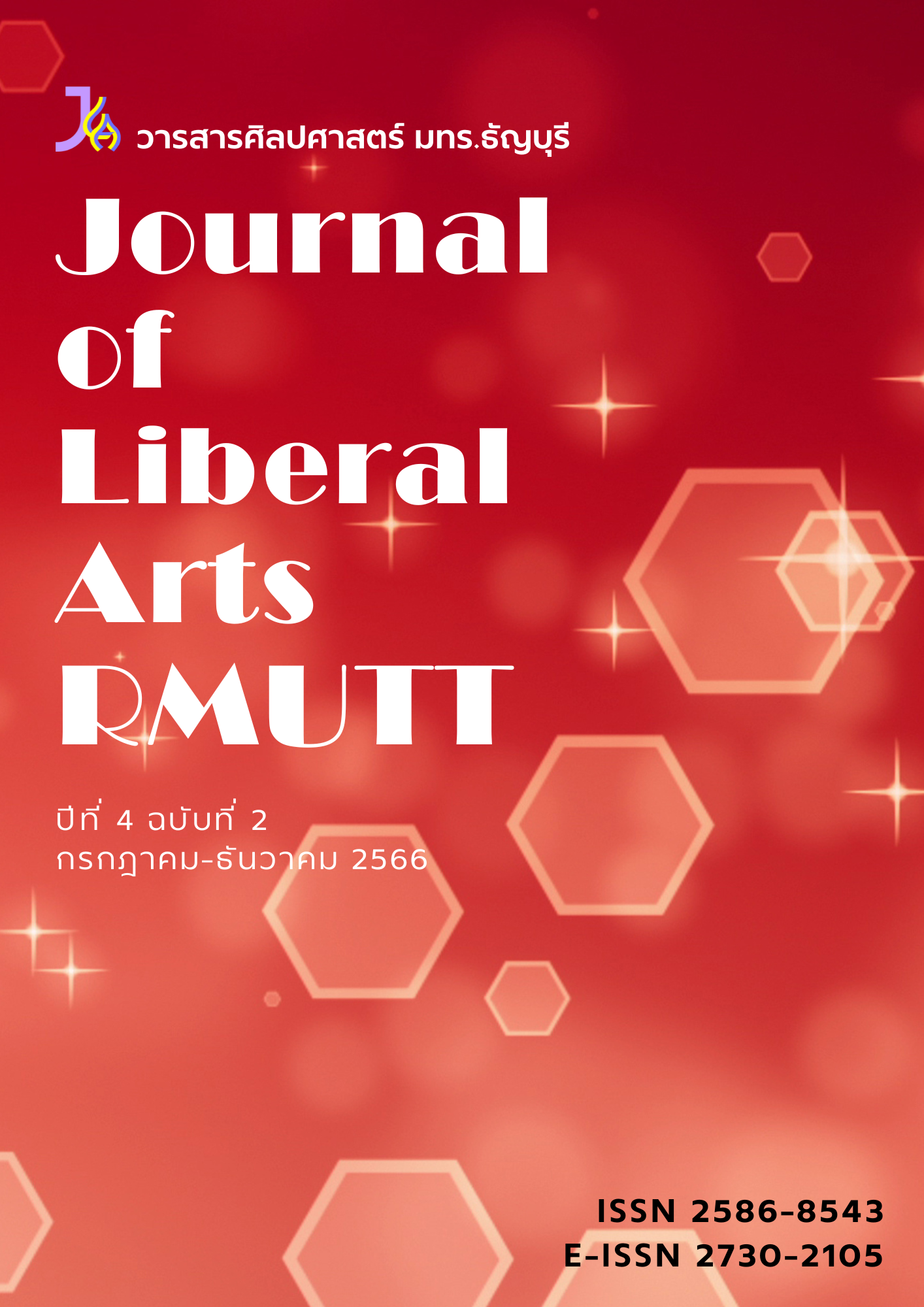Wisdom of Nang Talung carving identity of Nakhon Si Thammarat Province
DOI:
https://doi.org/10.60101/jla.2023.4.2.3234Keywords:
wisdom, shadow puppet leather, traditional age, contemporary ageAbstract
The shadow puppet carving of Nakhon Si Thammarat reflects traditional and contemporary shadow puppet wisdom that has changed in terms of ideas, beliefs, wisdom, integration, reproduction and has been applied in modern contexts. It was found that the leather selection wisdom for traditional shadow puppets was cows leathers chosen from calves or young cows. In contemporary age, animal skins that are popular for carving are cow, buffalo and other animal skins. The leather preparation in traditional time, when the animal skins were obtained, they were stretched taut to remove the fascia and animal fat that was attached, and buried in sand. In the traditional era, the animal skins will be tanned by soaking in water, boiling Garcinia or citrus fruits for 1-2 nights. In contemporary tanning, the dried leather is soaked in the water mixed with the vinegar to be slightly sour, for over an hour, and sometimes the leather is bought from the factory. The artisan applies the stylus or scratch awl to draw on the leather to create the traditional styles of the shadow puppet in the contemporary age, artisans keep the sketch of their ancestors to use as a style to create current shadow puppet characters. For the original carving method, the artisan chose some parts to engrave on the top and bottom of the shadow puppet. The essential tools for carving two ages included a chopping block as a mat for engraving, Tuttu or Mook as a hollow punch, and a carving knife. For the shadow puppet coloring, the leaf stalk of Nipa palm or Rattan was applied as a traditional paintbrush, and the primary color was black. In the contemporary age, leather coloring depended on picture style and utility. Making Mai Tup was similar in two ages by using a suitable stick as a core stick made from the bamboo that was not too young or old. Making controlling stick as a tool to pull the mouth part of the shadow puppet characters up or down was also similar in two ages. The sharpened bamboo was bent by holding it over the fire. Some artisans applied the plastic to sharpen it into a round shape and bounded it with the plastic band. The shadow puppet carving has remained the wisdom with essentially cultural capital. It has kept changing, adjusting, and maintaining interestingly in the contemporary age.
References
กิตติพร ใจบุญ. (2564). มรดกภูมิปัญญาทางวัฒนธรรมกับทรัพย์สินทางปัญญา: ข้อจำกัดและช่องว่างทางกฎหมาย. วารสารศิลปศาสตร์ มทร.ธัญบุรี, 2(2), 1-14.
จรูญ หยูทอง. (2559). การปรับตัวของหนังตะลุงในสถานการณ์การเปลี่ยนแปลง. วารสารรูสมิแล มหาวิทยาลัยสงขลานครินทร์ วิทยาเขตปัตตานี, 37(3), 42-52.
ชวน เพชรแก้ว. (2548). หนังตะลุงในประเทศไทย. สุราษฏร์ธานี: สำนักศิลปะและวัฒนธรรม มหาวิทยาลัยราชภัฏสุราษฏร์ธานี.
ชวน เพชรแก้ว. (2556). หนังตะลุง : การวิวัฒน์ที่ลงตัวในฐานะวัฒนธรรมภาคใต้. ใน เอกสารประกอบการประชุมวิชาการนานาชาติ “เสริมสร้างอัตลักษณ์อาเซียน : ศิลปะการเล่นเงาอาเซียน”. นครศรีธรรมราช: มหาวิทยาลัยวลัยลักษณ์.
เบญจวรรณ จันทร์พลูหลวง. (2545). หัตถศิลป์บนหนังตะลุงกับภูมิปัญญาชาวนครศรีธรรมราช. กรุงเทพฯ: ไทยวัฒนาพานิช.
ปริตตา เฉลิมเผ่า ก่ออนันตกุล. (2525). ความเปลี่ยนแปลงและความต่อเนื่องในศิลปะหนังตะลุง. กรุงเทพฯ: สถาบันไทยคดีศึกษา มหาวิทยาลัยธรรมศาสตร์.
วิมล ดำศรี. (2549). หนังตะลุงชั้นครูคู่เมืองนครศรีธรรมราช. นครศรีธรรมราช: คณะมนุษยศาสตร์และสังคมศาสตร์ และศูนย์ศิลปวัฒนธรรม มหาวิทยาลัยราชภัฏนครศรีธรรมราช.
ศิริพร ณ ถลาง. (2559). คติชนสร้างสรรค์ : บทสังเคราะห์และทฤษฏี. กรุงเทพฯ: ศูนย์มานุษยวิทยาสิรินธร (องค์การมหาชน).
สมัย สุทธิธรรม. (2550). หนังตะลุง. กรุงเทพฯ: ศิลปาบรรณาคาร.
สุดาวรรณ์ มีบัว และคณะ. (2564). การจัดการทุนทางวัฒนธรรมหนังตะลุงจังหวัดนครศรีธรรมราช. นครศรีธรรมราช: มหาวิทยาลัยราชภัฏนครศรีธรรมราช.
สุทธิวงศ์ พงศ์ไพบูลย์. (2540). ภูมิปัญญาชาวบ้านภาคใต้. วารสารทักษิณคดี มหาวิทยาลัยทักษิณ, 4(21), 22.
สุรินทร์ ทองทศ, เมธิรา ไกรนที และเชษฐา มุหะหมัด. (2566). หนังตะลุงกับการเปลี่ยนแปลงทางสังคมและวัฒนธรรมชุมชนท้องถิ่น. วารสารวิจัยวัฒนธรรม กระทรวงวัฒนธรรม, 5(2), 173-199.
เสรี พงศ์พิศ. (2534). สภาพปัญหาและทางเลือกของชนบทไทย. ใน การสัมมนาทางวิชาการเรื่องภูมิปัญญาชาวบ้านกับการดำเนินงานด้านวัฒนธรรมและการพัฒนาชนบท. กรุงเทพฯ: สำนักงานคณะกรรมการวัฒนธรรมแห่งชาติ.
Lim, S.L. (2013). The Role of Shadow Puppetry in the Development of Phatthalung Province, Thailand.
In Southeast Asia Club Conference Northern Illinois University, pp.1-19. Illinois: Northern Illinois University.
Downloads
Published
How to Cite
Issue
Section
License
Copyright (c) 2023 Journal of Liberal Arts RMUTT

This work is licensed under a Creative Commons Attribution-NonCommercial-NoDerivatives 4.0 International License.













